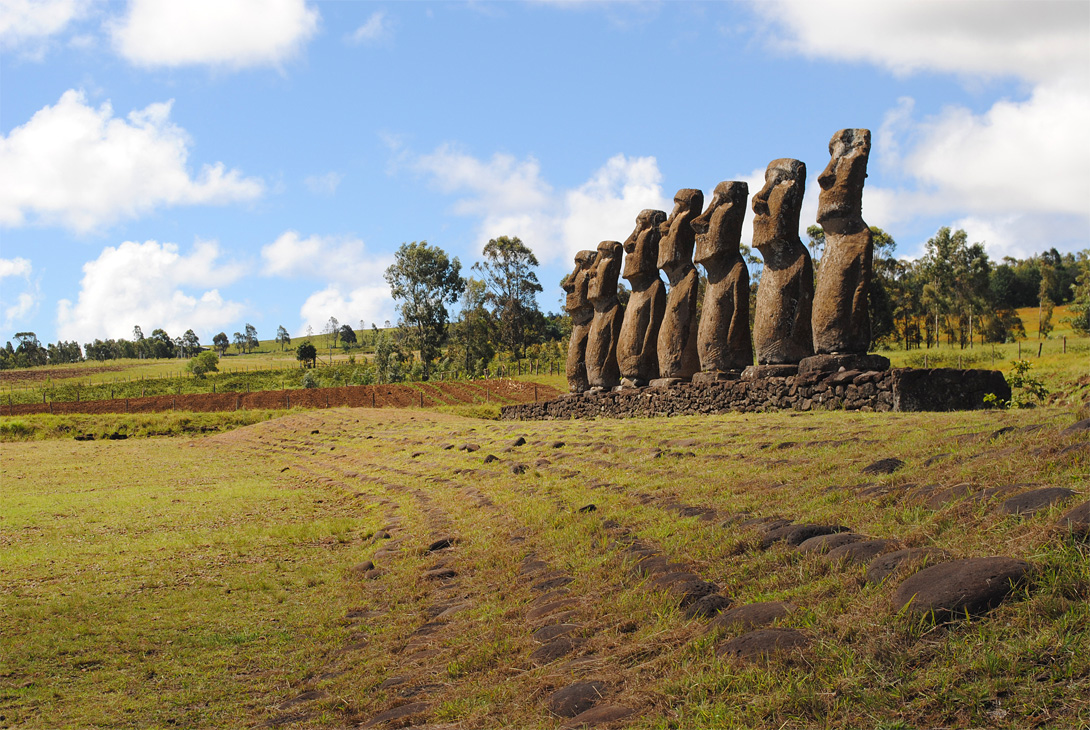Easter Island, known as Rapa Nui to its indigenous inhabitants, stands as a beacon for travelers seeking unparalleled beauty and profound cultural experiences. This remote Pacific island captivates with its enigmatic Moai statues—monolithic figures that have intrigued explorers and historians for centuries. For those drawn to destinations of extraordinary allure, Easter Island offers a journey into a landscape where natural splendor and ancient artistry converge.
The Enigmatic Moai Statues: History and Significance

Crafted between 1400 and 1650 AD, the Moai statues are monumental testaments to the ingenuity of the Rapa Nui people. These colossal figures, carved from volcanic tuff, are believed to represent ancestral figures, embodying the spirits of esteemed leaders and serving as protectors of the island's clans. The methods employed to transport these massive statues across the island remain a subject of fascination and debate, with theories suggesting a combination of log rollers and intricate rope techniques.
Top Moai Sites to Visit on Easter Island
To fully immerse oneself in the mystique of the Moai, certain sites are indispensable:
Rano Raraku

Often referred to as the "Moai factory," this volcanic crater served as the primary quarry for the statues. Visitors can observe numerous incomplete Moai, offering insight into the carving process.
- Highlights: The site features approximately 400 statues in various stages of completion, some partially buried, creating an otherworldly landscape.
Ahu Tongariki

- Insights: Home to the island's largest ceremonial platform, this site boasts 15 restored Moai standing in a commanding row against the Pacific backdrop.
- Photography Tips: Sunrise visits provide dramatic lighting, casting the statues in silhouette against vibrant skies.
Ahu Nau Nau

- Exploration: Located near the pristine Anakena Beach, this site features well-preserved Moai adorned with intricate carvings and red scoria "topknots" (pukao).
- Unique Aspect: The proximity to the beach allows for a combined cultural and leisure experience.
Ahu Tahai
- Overview: This restored ceremonial complex offers a picturesque setting, with solitary Moai overlooking the sea.
- Sunset Views: Renowned as an ideal spot to witness breathtaking sunsets, providing a serene atmosphere for reflection.
Ahu Akivi

- Unique Features: Distinctive for its seven Moai facing the ocean, unlike most others that face inland.
- Astronomical Significance: The statues are aligned to face the setting sun during the spring equinox, suggesting an advanced understanding of celestial events.
Beyond the Moai: Other Must-See Attractions
Easter Island's allure extends beyond its iconic statues:
Rano Kau and Orongo

- Exploring: This vast volcanic crater houses a freshwater lake and lush vegetation. Nearby, the ceremonial village of Orongo offers insights into the Birdman cult, with ancient petroglyphs and stone houses perched atop dramatic cliffs.
Anakena Beach

- Enjoying: A rare white coral sand beach fringed with palm trees, providing a tropical contrast to the island's rugged terrain. The warm, clear waters invite relaxation and swimming.
Ana Kakenga (The Two Windows Cave)

- Adventuring: A lava tube cave leading to two openings that frame panoramic ocean vistas, offering a sense of discovery and wonder.
Planning Your Visit: Practical Information
To ensure a seamless journey:
- Best Time to Visit
- Climate Considerations: The island experiences a subtropical climate, with warmer temperatures from December to March. However, visiting during the shoulder seasons can offer pleasant weather with fewer tourists.
- Climate Considerations: The island experiences a subtropical climate, with warmer temperatures from December to March. However, visiting during the shoulder seasons can offer pleasant weather with fewer tourists.
- Getting There
- Flight Options: LATAM Airlines operates regular flights from Santiago, Chile, to Mataveri International Airport on Easter Island. Booking in advance is advisable due to limited availability.
- Flight Options: LATAM Airlines operates regular flights from Santiago, Chile, to Mataveri International Airport on Easter Island. Booking in advance is advisable due to limited availability.
- Accommodation Options
- Overview: A range of lodging is available, from luxury eco-resorts to charming guesthouses. Staying in Hanga Roa, the island's main town, provides convenient access to amenities and tour operators.
- Overview: A range of lodging is available, from luxury eco-resorts to charming guesthouses. Staying in Hanga Roa, the island's main town, provides convenient access to amenities and tour operators.
- Transportation on the Island
- Mobility Options: Renting a car or scooter offers flexibility for exploration. Guided tours are also available, providing valuable historical and cultural context to the sites.
- Mobility Options: Renting a car or scooter offers flexibility for exploration. Guided tours are also available, providing valuable historical and cultural context to the sites.
Tips for an Enriching Experience
- Respect Local Customs
- Cultural Sensitivity: The Moai and other archaeological sites are sacred. Avoid touching or climbing on the statues, and adhere to posted guidelines.
- Cultural Sensitivity: The Moai and other archaeological sites are sacred. Avoid touching or climbing on the statues, and adhere to posted guidelines.
- Sustainable Tourism Practices
- Preservation Efforts: Stay on designated paths to protect the island's fragile ecosystem. Dispose of waste responsibly and support eco-friendly initiatives.
- Preservation Efforts: Stay on designated paths to protect the island's fragile ecosystem. Dispose of waste responsibly and support eco-friendly initiatives.
- Engage with the Local Community
- Authentic Interactions: Participate in cultural events, purchase handcrafted souvenirs from local artisans, and savor traditional Rapa Nui cuisine to enrich your understanding and support the community.
- Authentic Interactions: Participate in cultural events, purchase handcrafted souvenirs from local artisans, and savor traditional Rapa Nui cuisine to enrich your understanding and support the community.
A voyage to Easter Island transcends typical travel experiences, offering an intimate encounter with a captivating culture set against a backdrop of stunning natural beauty. The Moai statues stand as enduring symbols of human creativity and resilience, inviting travelers to explore their mysteries and the island's enchanting landscapes. Embarking on this journey promises not only visual splendor but also a profound connection to one of the world's most intriguing civilizations.




